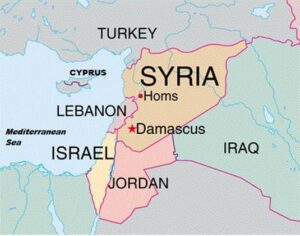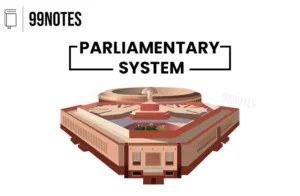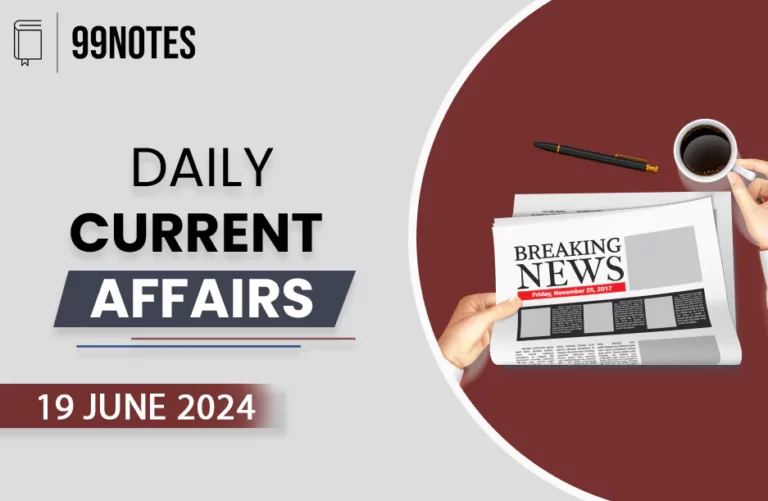16 October 2023 : Daily Current Affair
Daily Current Affairs
16-October-2023
1. New investments slowed again in Q2 of 2023-24: survey
Topic: GS3 – Indian economy
Context:
- Fresh investment announcements in Q2 2023-24 amounted to ₹6.9 lakh crore, representing a 13% drop from Q1 and a 21.5% decrease compared to the same period last year.
- This decline was influenced by reduced investment commitments from the Union government and foreign investors, coupled with a contraction in various sectors, including manufacturing, mining, infrastructure, and electricity.
Importance of investments for economy:
- Investments drive economic growth by increasing production capacity and stimulating demand.
- They create job opportunities, reducing unemployment and poverty.
- Investments in infrastructure enhance productivity, supporting business activities.
- Long-term investments can lead to technological advancements and innovation.
- Investment inflows can boost a country’s competitiveness and attractiveness to global markets.
- They contribute to increased tax revenue for the government, supporting public services.
- Investments can lead to increased exports, contributing to a favorable balance of trade.
- Encouraging investments fosters a stable and resilient economy, even during economic downturns.
Challenges regarding this for Indian economy:
- Infrastructure Gaps: Inadequate transportation, power, and digital infrastructure can deter investors due to logistical challenges and increased operational costs.
- Regulatory and Bureaucratic Hurdles: Complex regulations and bureaucratic procedures can discourage investors by creating delays and uncertainty in business operations.
- Legal System and Contract Enforcement: Delays and inefficiencies in the legal system can create uncertainty for investors, affecting contract enforcement and dispute resolution.
- Taxation Issues: Frequent changes in tax policies and complex tax structures can make it difficult for businesses to plan investments, impacting financial predictability.
- Corruption and Transparency: Corruption can deter investors, erode trust, and increase operational risks. Transparency is vital for investor confidence.
- Access to Finance: Limited access to financing options can hinder investment, especially for smaller businesses with constrained capital.
Question: Discuss the significant challenges faced by the Indian economy in attracting and sustaining investments. Provide insights into how addressing these challenges can promote economic growth and stability in India.”
2. The UN approved Kenya-led security mission to Haiti
Topic: GS2 – International relations
Context:
- The UN Security Council has approved an international intervention mission led by Kenya in response to Haiti’s request for urgent assistance in combating gang violence and restoring security.
What is happening in Haiti:
- Violence and Crisis in Haiti: Haiti has experienced a surge in violence, with armed groups taking control of significant portions of the country, including the capital, resulting in the deaths of nearly 2,800 people.
- In October the previous year, Haitian Prime Minister Ariel Henry sought international support after a group of gangs known as “G9 and Family” seized control of the main fuel port Varreux, leading to a nationwide crisis due to fuel subsidies cuts, blockades, and shortages, affecting transportation and medical services.
- Haitian leaders turned to the international community for help due to the overwhelmed police force and the need for a specialized armed force to counter gangs and their sponsors.
- Kenyan Leadership: Kenya proposed to lead the multinational force, with support from other countries like the Bahamas, Jamaica, and Antigua and Barbuda. Unlike the previous UN peacekeeping mission, this multi-national security mission (MSS) will not be operated by the UN.
- Mission Details: The mission will provide “operational support” to the Haitian National Police, improve security conditions, secure critical infrastructure, and have the authority to make arrests in coordination with Haitian police. The goal is to create favorable conditions for upcoming elections.
3. Study estimates the count of UAVs required for all the three services.
Topic: GS3 – defence modernisation
Context:
- General Anil Chauhan ordered two studies on major military platforms, specifically unmanned aerial vehicles (UAVs) and armoured helicopters, used by the three Services.
- The study on UAVs has been completed, with a recommendation to acquire 31 MQ-9B high-altitude long-endurance (HALE) UAVs and 155 medium-altitude long-endurance (MALE) UAVs.
Finding of the study:
- Upgrade of Israeli Heron MALE UAVs: The study recommends a major upgrade, including weaponization and satellite communication, for Israeli Heron MALE UAVs currently operated by the Services, with an estimated cost of ₹21,000 crore.
- Army’s Quest for Attack Helicopters: The Army has sought to operate attack helicopters independently to support its strike formations and has inducted the first batch of light combat helicopters (LCH).
- Upcoming Procurement: A deal for 156 LCH (90 for the Army and 66 for the Air Force) at an estimated cost of ₹45,000 crore is pending government approval.
- AH-64 Apache Procurement: The Cabinet Committee on Security has sanctioned the procurement of 39 AH-64 Apache attack helicopters for the Army.
Significance of UAVs in modern combat:
- Surveillance and Reconnaissance: UAVs provide real-time intelligence, surveillance, and reconnaissance capabilities, enhancing situational awareness.
- Precision Strikes: Armed UAVs can conduct precision strikes with minimal collateral damage.
- Risk Reduction: UAVs reduce the risk to human pilots in dangerous missions.
- Persistent Surveillance: They offer long-endurance flights for continuous monitoring and tracking.
- Quick Deployment: UAVs can be rapidly deployed in response to emerging threats.
- Cost-Effective: Compared to traditional aircraft, UAVs are often more cost-effective.
- Adaptability: UAVs can be adapted for various military roles, including reconnaissance, combat, and logistics support.
UAVs at India’s disposal:
- DRDO Rustom: This is an indigenous UAV developed by the Defense Research and Development Organization (DRDO). It comes in multiple variants, including Rustom-I, Rustom-II, and Rustom-H. These UAVs are used for reconnaissance, surveillance, and intelligence gathering.
- IAI Heron: India operates the Heron UAV, an Israeli-made medium-altitude long-endurance (MALE) drone. It is primarily used for surveillance and reconnaissance missions.
- IAI Searcher: Another Israeli UAV, the Searcher, is used by the Indian Armed Forces for surveillance, target acquisition, and reconnaissance tasks.
- Nishant: An indigenous UAV developed by DRDO, the Nishant UAV is used for reconnaissance and surveillance tasks.
- Netra: Netra is a tactical UAV developed by DRDO for use by the Indian Air Force. It is primarily used for intelligence, surveillance, and reconnaissance.
Question: Unmanned aerial vehicles (UAVs) are increasingly being used for a variety of civilian and military applications. Discuss the potential benefits and risks of UAVs, and suggest measures to mitigate the risks.
4. Sri Lanka moves towards RCEP; Bangladesh in queue
Topic: GS2 – International relations
Context:
- Sri Lanka has applied to join RCEP and is actively seeking support from countries like China, Japan, Malaysia, Indonesia, and Thailand.
- Bangladesh’s Commerce Ministry has recommended joining RCEP but will make a final decision after elections in January 2024.
- India’s Exit from RCEP: India withdrew from the Regional Comprehensive Economic Partnership (RCEP) agreement four years ago, expressing concerns about service mobility, the influx of Chinese goods, and objections from domestic agriculture and small businesses.
- Potential Implications Sri Lanka and Bangladesh joining RCEP: Both Sri Lanka and Bangladesh recognize that joining RCEP would allow access to the Association of South East Asian Nations (ASEAN)-led group and open doors to larger markets. RCEP members represent 30% of the global GDP.
- India’s Concerns: India has not indicated a reconsideration of its decision to leave RCEP. If neighboring countries join RCEP, it could pose concerns for India regarding market access and competition with Chinese trade.
- Reasons for the Move: Sri Lanka and Bangladesh are considering more open and competitive trade policies to spread their markets, especially as they face changes in global trade preferences and graduation from Least Developed Country status in the case of Bangladesh.
What is Regional Comprehensive Economic Partnership (RCEP):
- The Regional Comprehensive Economic Partnership (RCEP) is a free trade agreement among 15 countries in the Asia-Pacific region.
- It was signed in 2020 and includes major economies like China, Japan, South Korea, and the member states of the Association of Southeast Asian Nations (ASEAN).
- RCEP aims to promote economic integration, reduce trade barriers, and facilitate cross-border trade and investment, creating one of the world’s largest trading blocs.
India’s concerns about RCEP:
- Trade Imbalance: India was concerned about a potential trade imbalance, with an influx of Chinese goods.
- Agricultural Sector: The domestic agricultural sector was worried about competition from RCEP member countries.
- Services Sector: Concerns were raised about mobility in the services sector.
- Small Businesses: India’s small businesses were apprehensive about the impact on their competitiveness.
- Impact on Local Industries: Fears that local industries might struggle to compete with RCEP member countries.
- China’s Dominance: Worries that the agreement might lead to Chinese economic dominance in the region.
Question: What were the key concerns that led to India’s withdrawal from the Regional Comprehensive Economic Partnership (RCEP) agreement, and what are the implications of these concerns for India’s trade and economic policies?
5. Centre likely to raise age of retirement of scientists to 65
Topic: GS2 – governance
Context:
- The Indian Ministry of Science and Technology is considering a proposal to raise the retirement age of scientists to 65, aimed at retaining top senior scientists in government positions.
- Presently, most government scientists retire at 60, with exceptions for scientists at the Indian Council of Agricultural Research (ICAR) and the Indian Council of Medical Research (ICMR) who retire at 62.
Potential implications of this decision:
- Retaining Top Talent: Increasing the retirement age may help retain experienced senior scientists in government positions.
- Parity with Academia: Scientists in government roles will have retirement age parity with those in universities and Indian Institutes of Technology (IITs).
- Enhanced Research Continuity: Longer tenures may lead to greater continuity and impact in research projects and initiatives.
- Reduced Turnover: It could reduce the turnover of senior scientists who seek academic careers due to higher retirement ages in universities.
- Human Resource Management: The decision may improve human resource management in scientific institutions and ensure the expertise of senior scientists is not lost.
- Government Commitment: Demonstrates the government’s commitment to nurturing and utilizing scientific talent.
Question: Discuss the potential benefits and challenges of increasing the retirement age of scientists in government positions, and its implications for the field of scientific research and development in India.
6. Kaziranga sanctuary reopens with tribute to British-era officer
Topic: GS3 – environment and ecology
Context:
- The Kaziranga National Park and Tiger Reserve in Assam, known for its one-horned rhinoceros population, reopened for tourists in October.
- A literary tribute was paid to Patrick D. Stracey, a British-era forest officer who played a crucial role in renaming the Kaziranga Game Sanctuary as a wildlife sanctuary in 1950.
About Kaziranga national Park:
Kaziranga National Park, located in the Indian state of Assam, is a world-renowned protected area known for its remarkable wildlife conservation efforts and biodiversity. Here are some key points about Kaziranga National Park:
- Location: Kaziranga is situated in the Golaghat and Nagaon districts of Assam, in northeastern India.
- World Heritage Site: The park was declared a UNESCO World Heritage Site in 1985 due to its exceptional natural values and efforts in preserving the one-horned Indian rhinoceros.
- Wildlife: Kaziranga is famous for its population of the Indian rhinoceros, tigers, elephants, wild water buffalo, and swamp deer. It is home to a wide variety of wildlife and bird species.
- One-Horned Rhinoceros: Kaziranga is a stronghold for the one-horned Indian rhinoceros. The park’s conservation efforts have been instrumental in reviving the rhino population.
- Biodiversity: The park is a biodiversity hotspot with diverse ecosystems, including grasslands, wetlands, and forests. It supports a rich variety of flora and fauna.
- Rivers: The Brahmaputra River flows through Kaziranga, shaping its landscape and providing a habitat for several aquatic species.
- Challenges: Kaziranga faces challenges such as habitat loss, poaching, and human-wildlife conflicts, which require ongoing conservation measures.
7. New shelters, special fuel, batteries: Indian armour gets ready for winter in Ladakh
Topic: GS3- Defence Technology
Context:
- The Army has taken numerous precautions to maintain hundreds of tanks and other mechanised vehicles during the fourth winter of their deployment in eastern Ladakh when the temperature drops several degrees below freezing point.
- These precautions range from temperature-controlled shelters to special fuel and batteries.
Details:
- Since the Chinese incursions in May 2020, when the standoff along the Line of Actual Control began, the Army has stationed more than 400, or roughly three brigades, of T-72 and T-90 tanks and BMPs (infantry battle vehicles) of Russian manufacture in eastern Ladakh.
- Previously, only a third of these resources were deployed in the area.
- While tanks were initially introduced throughout Zoji La in 1948, frontline MBTs (main battle tanks), such as the T90, have just recently been introduced in the area.
- Although Ladakh’s dry desert-like terrain is well suited for the deployment of tanks and mechanised vehicles, and its broad river valley is suitable for manoeuvres, maintaining such a heavy fleet is a tremendous challenge, particularly in the high altitudes of eastern Ladakh where temperatures during the winter can go up to minus 30-degree Celsius.
Challenges:
- A firing gun system and tracked chassis make up a tank.
- Extreme cold weather has an impact on the hydraulics in the gun system; in the chassis, it has an impact on the fuel system and lubrication.
- Subzero temperatures and an oxygen-deficient atmosphere cause the fuel and lubricants to freeze, which affects the platforms’ mechanical efficiency.
- Additionally affected are the hydraulics, electronics, and batteries of the very sophisticated platforms.
Steps taken:
- The Army has turned to special fuel and multigrade lubricants that are resistant to extremely low temperature ranges to combat this and ensure that the platforms are battle-ready and can be started at short notice.
- These fuel and lubricants, which were created for the alpine areas, have recently been made available by Indian companies.
- Improved hydraulic fluids that do not freeze at lower temperatures or lose viscosity due to extensive operations for both tanks and artillery guns are also being introduced in the region.
- For the heavy vehicles deployed in eastern Ladakh, the Army is also receiving Pure Lead Tin (PLT) batteries, which are believed to have superior endurance to low temperatures than typical lead-acid batteries.
- These batteries are now being utilised for trucks and are being evaluated for heavier armoured vehicles.
- These batteries are essential for starting tanks at very cold temperatures since they provide high current.
- Regular movement drills, operational checks, and day/night training are conducted to keep the crew and tanks combat-ready at all times.
8. Fighting erupts in north: Israel, Hezbollah trade fire
Topic: GS2-IR
Context:
- A Cross-border fire broke out between Israel and the Lebanese militant organisation Hezbollah, killing at least one person on the Israeli side of the border.
What is Hezbollah?
- Shiite Muslim political party and militant organisation Hezbollah is established in Lebanon, where its strong security infrastructure, political structure, and social services network have helped to promote its reputation as “a state within a state.”
- The Iran-backed organisation is motivated by its enmity to Israel and its resistance to Western dominance in the Middle East.
- It was founded in the chaos of the fifteen-year Lebanese Civil War.
- Israel and the United States have branded Hezbollah as a terrorist group.
- The armed wing of Hezbollah was outlawed by EU foreign ministers in 2013, but not its political activities there.
- As a result, its military leaders may be subject to penalties.

9. GI tag for Goan Cashew
Topic: Prelims
Context:
- GOAN cashew (kernel) recently received the geographical indicator (GI) tag
About GI tag:
- Products coming from a particular geographic area are given a GI tag, which denotes special features and characteristics.
- In essence, it acts like a trademark on the global market.
Significance of GI Tag for Goan Cashew:
- The GI tag guarantees that cashews with this indication are genuine goods coming from Goa. This makes it easier for customers to identify between real Goan cashews and imitations that are frequently promoted as such but are actually produced from outside the state.
- The GI tag may be used as a trademark on the worldwide market by producers and processors of Goan cashews. This protection helps to preserve the reputation and quality of Goan cashews.
- Cashew cultivation has been practised in Goa for a very long time, and the GI label aids in protecting the rich cultural and historical heritage of Goan cashews.
- The GI tag may increase consumer demand for genuine Goan cashews, which would be advantageous to regional cashew growers, manufacturers, and the state’s economy.
Challenges Recently Faced by the Goan Cashew Industry
- Due to the inflow of less expensive imported cashews that were frequently mislabeled as “Goan cashews” by small traders from other states, the Goan cashew industry has experienced difficulties recently. The reputation of Goan cashews was harmed by these traders’ inconsistent adherence to quality and compliance standards.
- Traditional Goan cashew processors saw a fall in sales as a result of the competition from cheaper cashews, as well as higher minimum wages and compliance regulations compared to other states.
- Goa currently has more than 15 processing units, down from 40 in 2005.
- The GI tag is anticipated to help with some of these problems by guaranteeing that genuine Goan cashews are safeguarded, advertised, and accepted both domestically and abroad.
- It will assist in differentiating Goan cashews from other varieties and could possibly increase demand for the area’s distinctive cashew products.
- Furthermore, it is anticipated that the government’s crackdown on unlawful marketing techniques will further safeguard the originality of Goan cashews and help the local economy.
10. Citing deepfakes, Govt looks at IT rules to make WhatsApp disclose source ID
Topic: GS2-governance, GS3- Science and tech
Context:
- The government is looking to activate a contentious rule that would oblige WhatsApp to provide details about the message’s original sender in light of the rise of artificial intelligence (AI)-driven misinformation on messaging platforms as the nation prepares for the Lok Sabha elections in 2024.
Details
- The government is believed to be in the process of sending an order to the messaging company under the Information Technology (IT) Rules, 2021, seeking the identity of the individuals who first shared the videos on the platform.
- The basis for this is a number of deep fake videos of politicians being shared on WhatsApp.
What is a deepfake?
- Deepfakes are a collection of fake images and audio that have been stitched together using machine learning algorithms to spread misinformation and to mimic the voice or appearance of a genuine person. It has the ability to construct fictional characters and to make false statements and actions by actual individuals.
- According to a blog post by cybersecurity company Norton, deepfake technology is now being utilised for malicious activities like scams and hoaxes, celebrity pornography, election meddling, social engineering, automated disinformation attacks, identity theft, and financial fraud.
- Former American presidents Barack Obama and Donald Trump, Indian Prime Minister Narendra Modi, Facebook CEO Mark Zuckerberg, and Hollywood star Tom Cruise, among others, have all been impersonated using deepfake technology.
11. Pasmanda Muslims
Topic: Prelims
Context:
- The ruling party has launched an outreach plan with the country’s largest religious minority in mind, the Sufi Samvad Maha Abhiyan or the Sufi discourse, in response to the much-discussed Pasmanda Muslim outreach which was supported by Prime Minister Narendra Modi himself.
Who are the Pasmanda Muslims?
- Description: The term “Pasmanda,” from Persian, refers to the depressed classes of Muslims and emphasises their willful or conscious marginalisation.
- It means the “ones left behind.”
- When Ali Anwar Ansari established the Pasmanda Muslim Mahaz in 1998, he used the title “Pasmanda Muslims” for the first time.
- Pasmanda has evolved into an umbrella identity that is used by tribal, Dalit, and backward Muslims to combat caste-based prejudice against them in the society.
What is the demographic distribution of Pasmanda Muslims?
- A precise assessment of the current population size and demographic makeup of Pasmanda Muslims is not known because there has never been a caste census.
- Activists from the Pasmanda movement claim that between 80 and 85 percent of Muslims in India are Pasmandas.
- According to the 1871 census, only 19% of Muslims in India belonged to the upper caste, while 81% were from the lower castes.
What do Pasmanda Muslims want?
- The main requests include:
- performing a caste census,
- reorganising the current reservation categories,
- providing governmental assistance to artisans, craftspeople, and agricultural labourers who are some of the most marginalised sectors in the society.
- In a resolution adopted by a number of Pasmanda organisations prior to the 2014 Lok Sabha elections, it was demanded that Dalit Muslims be added to the SC list and that the OBC quota be revised to add the most disadvantaged Muslims to the category of Extremely Backward Castes (EBCs) at the federal and state levels.
For Enquiry

16 October 2023 : Daily Current Affair

16 October 2023 : The Hindu Editorial Notes PDF

14 Oct 2023 : Daily Quiz

14 Oct 2023 : Daily Answer Writing

14 Oct 2023 : Indian Express

14 Oct 2023 : PIB

14 October 2023 : Daily Current Affair

14 October 2023 : The Hindu Editorial Notes PDF

Parliamentary System

Kurukshetra Summary: August 2023
Daily Current Affairs 16 October 2023 : Daily Current Affair Daily Current Affairs
16-October-2023
1. New investments slowed again in Q2 of 2023-24: survey
Topic:…
October 2023 The Hindu 16 October 2023 : The Hindu Editorial Notes PDF The Hindu Editorial
16-October-2023
1. The world needs to stop taking water for granted.
Topic: GS3…
Daily Quiz 14 Oct 2023 : Daily Quiz 14 Oct 2023 : Daily Quiz…
mains answer writing 14 Oct 2023 : Daily Answer Writing Mains Answer Writing
14-october-2023
Q1) Discuss the crucial role played by the National Commission…
Indian Express 14 Oct 2023 : Indian Express Indian Express
14-October-2023
1) Cost of Dal-Roti
Context:
Food inflation has recently been primarily…
October 2023 PIB 14 Oct 2023 : PIB PRESS INFORMATION BUREAU
14-Oct -2023
1. Minister Rajeev Chandrasekhar releases draft National Strategy…
Daily Current Affairs 14 October 2023 : Daily Current Affair Daily Current Affairs
14-October-2023
1. Israel tells Palestinians to leave northern Gaza
Topic: GS2…
October 2023 The Hindu 14 October 2023 : The Hindu Editorial Notes PDF The Hindu Editorial
14-October-2023
1. India must pressure Israel to act responsibly in the face of…
Polity Parliamentary System In modern democracies, two kinds of relationships exist between the Legislature and the Executive; it…
kurukshetra summary Kurukshetra Summary: August 2023 Article 1: Adequate Nutrition for Women and Children
Importance of Women’s Nutrition:
Women’s…





